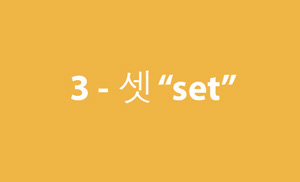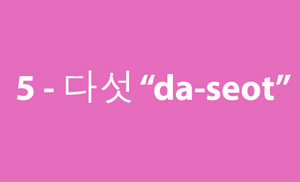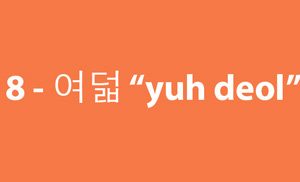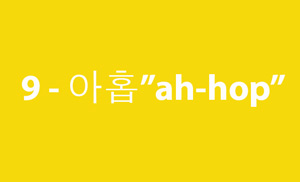Taekwondo 태권도Taekwondo Preschool
When you reach senior belt you are expected to guide the junior belts when they are beginning Taekwondo such as showing by example. To advance from one rank to the next, students typically complete promotion tests in which they demonstrate their proficiency in the various aspects of the art before a panel of judges or their teacher. View Taekwondo belt levels »

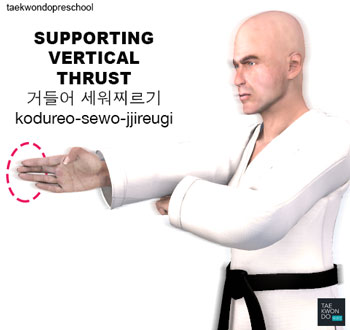


Supporting Vertical Thrust
거들어 세워찌르기 kodureo-sewo-jjireugi
Difficulty Level: Intermediate Technique: Strikes ( 치기 chigi )
Supporting Vertical Thrust ( 거들어 세워찌르기 kodureo-sewo-jjireugi ) is an intermediate level combination technique that allows one to block ( 막기 makgi ) an attack and then strike ( 치기 chigi ) back right away at the opponent. The Supporting Vertical Thrust ( 거들어 세워찌르기 kodureo-sewo-jjireugi ) is a form of Vertical Thrust ( 세워찌르기 sewo-jjireugi ) in taekwondo.
In actual use, the practitioner performs a Palm Heel Pressing Block ( 바탕손 눌러막기 batangson-nulleo-makgi ) with one hand to block ( 막기 makgi ) an attack aimed at the torso and then strikes right away with the other hand performing a Spearhand Vertical Thrust ( 편손끝 세워찌르기 pyeonsonkkeut-sewo-jjireugi ) to the opponent.
The ideal suitable target for the Spearhand Vertical Thrust ( 편손끝 세워찌르기 pyeonsonkkeut-sewo-jjireugi ) is the sternum ( 흉골 hyung-gol ), though the eyes ( 눈 nun ) and throat ( 목구멍 mokgumeong ) areas are also possible. This technique is generally unsuitable against most other targets due to the high probability that one might break their fingers. Remember to keep the striking fingers tightly together, tensing the muscles during impact, and stay near the opponent.
- Palm Heel Pressing Block ( 바탕손 눌러막기 batangson-nulleo-makgi )
- Spearhand Vertical Thrust ( 편손끝 세워찌르기 pyeonsonkkeut-sewo-jjireugi )
Strikers may combine techniques in a series to ensure the strike impacts their opponents. The Palm Heel Pressing Block ( 바탕손 눌러막기 batangson-nulleo-makgi ) allows the practitioner a chance to get in close to the opponent's body, while proper footwork ( 딛기 ditgi ) is used to enable the proper balancing of the body as well.
Strikes should channel force through a small area of the attacker's body. Focus helps in achieving proper penetration and in maximizing the damage at the point of impact. Experienced strikers learn through repetition and muscle memory when (not just how) to launch particular strikes, based on the circumstances they are facing.
Use of this strike ( 치기 chigi ) is featured prominently in many of the World Taekwondo (WT) Poomse. Taekwondo poomse are the learning ground for real combat. As such, the muscles of the body should be lightly relaxed in order to perform the pattern with fluidity, speed and grace. Muscles should only be tensed at the moment of imaginary impact in order to commute maximum power to any individual taekwondo technique. The strike is also performed commonly in self-defense ( 호신술 hosinsool ), one-step sparring, and demonstration events.
In taekwondo sparring ( 겨루기 gyeorugi ), the Spearhand Vertical Thrust ( 편손끝 세워찌르기 pyeonsonkkeut-sewo-jjireugi ) is unsuitable due to the high probability that one might break their fingers. It is also an illegal technique to strike the face ( 얼굴 eolgul ) of the opponent during sparring competitions which could lead to a penalty ( 감점 gamjeom ) or warning ( 경 고 gyeong-go ) from the referee.
Training Methods
How well one improves with training depends on several factors, such as the frequency it is engaged in, and the type of feedback that is available for improvement. If a student does not train often enough, reinforcement fades, and he or she is likely to forget what was learned.
The strike is best learned initially striking at the air as though there is an opponent but focusing on the form, speed, and technique; then moving on to soft surfaces striking punch mitts and target pads. Large heavy bags are used more for strength and endurance, while smaller targets such as punch mitts and target pads focus on faster hand speed, timing and coordination. Target pads are useful for training mobility and accuracy on a moving target.
Difficulty of Technique
Taekwondo students of geup ranking learn the most basic techniques first, and then move on to more advanced and difficult techniques as they approach 1st Dan Black Belt. The more difficult the technique, the more practice may be needed for the purpose of improving or mastering it, as in the phrase 'practice makes perfect'. Every technique must display the requisite speed, balance, power and firmness to be realistically used as an attack or defense move.
* Please see a certified Master Instructor ( 사범님 sabeomnim ) for training. Proper guidance and instructions are needed to ensure safe training.
Promotion Tests
Students often undergo periodic testing and grading by their own Master Instructor ( 사범님 sabeomnim ) in order to advance to a higher level of recognized achievement such as a different belt color. They need to demonstrate their proficiency in the various aspects of the art such as the execution of patterns ( 품새 poomse ), which combine various techniques in specific sequences.
Supporting Vertical Thrust ( 거들어 세워찌르기 kodureo-sewo-jjireugi ) is a requirement for the below belt levels (Techniques vary between schools). Promotion from one belt level to the next can proceed rapidly in some schools, since schools often allow geup promotions every two, three, or four months. Students of geup rank learn the most basic techniques first, and then move on to more advanced techniques as they approach first dan black belt. View Promotion Tests »
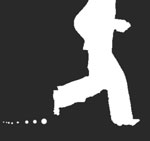
Training Safety Precautions
Usually before the taekwondo class starts, the master ( 사범님 sabeomnim ) instructs the students to jog around the dojang to warmup. Depending on the size of the dojang, several laps are done. Risk of injury can be reduced by completing an effective warm-up consisting of a heart raiser to get your pulse up, followed by sport specific dynamic stretches (stretches whilst moving).
* Please see a certified Master Instructor ( 사범님 sabeomnim ) for training. Proper guidance and instructions are needed to ensure safe training.
Advertisement
Supporting Vertical Thrust ( 거들어 세워찌르기 kodureo-sewo-jjireugi )
Striking Surface
Various surfaces of the hand may be engaged as the striking surface depending on which area of the opponents body which is being targeted. This leads to a large array of hand positions. For more information on Impact Surface Areas »
( Click image for additional information)
Suitable Targets
Experienced strikers learn through repetition and muscle memory when (not just how) to launch particular strikes, based on the circumstances they are facing. Focus helps in achieving proper penetration and in maximizing the damage at the point of impact to the area of the opponents body which is being targeted. For more information on Impact Surface Areas »
( Click image for additional information)
Technique Injuries
Collisions with the ground, objects, and other taekwondo practitioners are common, and unexpected dynamic forces on limbs and joints can cause injury. Taekwondo injuries can also occur in techniques if done improperly or from overuse of a particular body part. Taking a break from training or reducing the volume and the intensity of the training will allow the body to recover. For more information on Injuries »
( Click image for additional information)
Common Mistakes when Performing the Technique
When performing the technique, there will be more mistakes as a beginner and as the practitioner advances through the rankings, they will have learned and improved from the past. How well one improves with training depends on several factors, such as the frequency it is engaged in, and the type of feedback that is available for improvement.
( Click image for additional information)
Some Combination Techniques after the Strike
After striking with the technique, the taekwondo practitioner may immediately combination strike again to the opponent with a kick ( 차기 chagi ) or punch ( 지르기 jireugi ). When the opponent is being attacked, they may be vulnerable recovering from the initial blow, strategic positioning by the attacker to gain advantage, imbalance by defender, and many more factors. Practitioners may combine techniques in a series to ensure one or more strikes impact their opponents.
( Click image for additional information)
Some Stance(s) ( 서기 sogi ) used with the Strike
An example of the union of mental and physical discipline is the combination of stance ( 서기 sogi ), footwork ( 딛기 ditgi ), and technique (either with kick, block and/or strike), which requires both physical mastery of the technique and the concentration to focus one's power. Experienced practitioners learn through repetition and muscle memory when (not just how) to launch particular techniques, based on the circumstances they are facing.
( Click image for additional information)
Supporting Vertical Thrust ( 거들어 세워찌르기 kodureo-sewo-jjireugi )
Use in Sparring ( 겨루기 gyeorugi )
Under World Taekwondo (WT) and Olympic rules, sparring is a full-contact event and takes place between two competitors in an area measuring 8 meters square. A win can occur by points, or if one competitor is unable to continue (knockout) the other competitor wins. Points are awarded for permitted, accurate, and powerful techniques to the legal scoring areas; light contact does not score any points. For more information on World Taekwondo (WT) Tournament Sparring » 
The Supporting Vertical Thrust ( 거들어 세워찌르기 kodureo-sewo-jjireugi ) is not used in World Taekwondo (WT) Sparring ( 겨루기 gyeorugi ) tournaments. It is an illegal technique to strike the face of the opponent during sparring competitions which could lead to a penalty or warning.
Penalties on any prohibited acts shall be declared by the referee. Penalties are divided into Warnings ( 경 고 gyeong-go ) and Deduction Penalty ( 감점 gamjeom ). The technique is more suited for Self-Defense ( 호신술 hosinsool ) usage. For more information on Prohibited Acts and Penalties »
( Click image for additional information)
Use in Self-Defense ( 호신술 hosinsool ) Applications
Self-Defense is to protect yourself from being attacked from would-be aggressors. It is a countermeasure that involves defending the health and well-being of oneself from harm and is designed primarily to cause injury or quickly incapacitate an attacker, in addition to being a deterrent against them. Attackers are typically larger, stronger, and are often armed or have an accomplice. With proper execution attackers may be incapacitated with a single blow, which lessens the number of attacks with multiple people. For more information on Self-Defense ( 호신술 hosinsool ) »
Each technique must be correctly timed and aligned in order to defend effectively. Practitioners must have their body weight correctly distributed during the stance ( 서기 sogi ) including proper footwork ( 딛기 ditgi ). The strike is commonly performed during Self-Defense ( 호신술 hosinsool ) scenarios.
( Click image for additional information)
The self-defense ( 호신술 hosinsool ) applications would be difficult to score in sparring ( 겨루기 gyeorugi ) as they are designed primarily to cause injury or quickly incapacitate an adversary. Suitable targets for self-defense are less restrictive than sparring competitions and offers more areas to strike the opponent. An illegal technique in sparring competitions could lead to a penalty ( 감점 gamjeom ) or warning ( 경 고 gyeong-go ) but not in self-defense.
( Click image for additional information)
Use in One-Step Sparring
One-Step Sparring is performed with a partner in which predefined movements are practiced. One student is the attacker while the other student responds with defenses, counterattacks, and/or other actions, based on part of the predefined movements. For more information on One-Step Sparring »
The strike is commonly featured during One-Step Sparring practice. Fundamentally, taekwondo One-Step Sparring is one of the learning grounds for real combat. As such, every technique including stance ( 서기 sogi ) must display the requisite speed, power and firmness to be realistically used as an attack or defense move. One-Step Sparring varies between schools.
( Click image for additional information)
Use in Breaking ( 격파 gyeokpa )
The discipline of destroying inanimate objects such as wooden boards, baseball bats, ice blocks or cement bricks and is a feature common to martial arts including taekwondo. A single board or stack of boards may be broken or, alternatively, a series of boards may be broken in a pre-set sequence utilizing a variety of strikes. Advanced competitors may even break several boards in a single jump with multiple kicks before landing. For more information on Breaking ( 격파 gyeokpa ) »
In use, the strike is not featured during Breaking ( 격파 gyeokpa ) events. General qualities that judges look for in any taekwondo practitioner include proper breathing technique and body control. The diaphragm must be engaged in deep breathing, shallow breathing concentrated in the upper abdomen results in raised shoulders and stressed muscles. Breaking ( 격파 gyeokpa ) varies between schools.
( Click image for additional information)
Supporting Vertical Thrust ( 거들어 세워찌르기 kodureo-sewo-jjireugi )
Use in Patterns ( 품새 poomse )
Strike is introduced in the following patterns:
TAEGEUK #: 4
BLACK BELT: Taebaek 품새 태백 ( 3rd Dan )
Poomse is the foundation for the teaching of taekwondo. A poomse or form is a detailed pattern of defense-and-attack motions and techniques used in traditional martial arts. Poomse is useful in developing proper kinetics, mental and physical fortitude.
( Click image for additional information)
Most Kukkiwon 국기원 schools will use the poomse taegeuk whereas a few schools will use the poomse palgwe. The meanings, trigrams and symbols are shared by both poomse taegeuk and poomse palgwe, however the sequence of movements is different. The first 8 forms of the set of poomse differ from each other, whereas the last 9 forms (Black Belt forms) of the set are shared between the two sets. All students studying in World Taekwondo (WT) Kukkiwon style must learn these forms, or taegeuk, to advance to a higher belt level. There are eight taegeuk forms, each one similar to the previous one, but each time with more complicated techniques to display the students' mastery of the techniques learned during lessons, as well as the ability to interconnect these techniques.
For more information on taekwondo patterns refer to Poomse 품새 Section »
Learn other taekwondo strikes on the Main Strikes Section »
Use in Demonstrations
To promote taekwondo for its emphasis on high kicking and fast hand techniques, taekwondo schools perform at tournaments, community events, shopping malls, parks, and tv shows. Demonstrations vary from school to school, but may include such elements as the execution of poomse ( 품새 poomse ), which combine various techniques in specific sequences; the breaking of boards to demonstrate the ability to use techniques with both power and control; sparring ( 겨루기 gyeorugi ) and self-defense ( 호신술 hosinsool ) to demonstrate the practical application and control of techniques; physical fitness usually with push-ups and sit-ups. For more information on Demonstrations »
The strike is commonly used in demonstration activities such as when performing poomse ( 품새 poomse ) which is the foundation for the teaching of taekwondo. A poomse ( 품새 poomse ) is a series of movements linked together in a prescribed sequence which is significant to demonstrate. As such, every technique must display the requisite speed, power and firmness to be realistically used as an attack or defense move.
( Click image for additional information)
Use in Warming-Up
A warm-up generally consists of a gradual increase in intensity in physical activity, joint mobility exercise, and stretching, followed by the activity. Warming-up brings the body to a condition at which it safely responds to nerve signals for quick and efficient action. For more information on Warming-Up »
In addition to being a strike in itself, the strike is an exercise used by many instructors to teach the principle of focusing, stretching, relaxing the muscles, increasing the range of motion and flexibility, something which is considered important in taekwondo. The result is a feeling of increased muscle control, flexibility and range of motion.
( Click image for additional information)

Did you know?
Korean language is often used in taekwondo practice. During promotion tests, practitioners are usually asked what certain Korean words used in class mean. Korean numerals may be used as prompts or commands. Often, students count in Korean during their class such as when stretching, warmups, kicking drills, and more. For more information View Korean Numerals »
RESOURCES
This article uses material from the Wikipedia articles "Taekwondo" and "Korean Numerals" which is released under the Creative Commons Attribution-Share-Alike License 3.0.
Supporting Vertical Thrust ( 거들어 세워찌르기 kodureo-sewo-jjireugi )

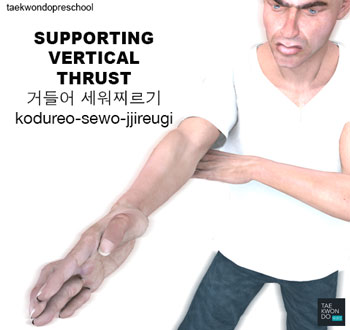
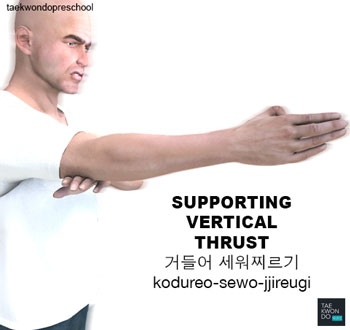

Training Highlights Summary
The Strike contains many key point highlights. There are some that are simple and straightforward but then some are complex and detailed that require repeated training to learn and master.
- technique that allows one to block and attack at the same time
- intended striking areas are with the tips of the fingers namely the Flat Fingertips ( 편손끝 pyeonsonkkeut )
- suitable targets are the sternum ( 흉골 hyung-gol ), the eyes ( 눈 nun ) and throat ( 목구멍 mokgumeong )
- technique is generally unsuitable against most other targets due to the high probability that one might break their fingers
Strength Requirement of the Technique
Most strikes should generally be thrown with some measure of shifting body weight supporting the blow. The striker in combat should attempt to strike through the target area, not just contact the surface. Some strikes do not need as much strength as they target vulnerable areas such as the eyes ( 눈 nun ), neck ( 목 mok ) or sternum ( 흉골 hyung-gol ). The below is an approximate measurement of how much strength the strike requires from the practitioner to be effective.
Precision of Striking Technique
With proper execution opponents may be incapacitated with a single striking blow, which lessens the number of further strikes. Some techniques can strike with more precision which will often cripple or knockout the opponent. The below is an approximate measurement of how precise the strike requires from the practitioner to be effective.
Experienced practitioners learn through repetition and muscle memory when (not just how) to launch particular strikes, based on the circumstances they are facing.
* Please see a certified Master Instructor ( 사범님 sabeomnim ) for training. Proper guidance and instructions are needed to ensure safe training.
Advertisement

Quiz
Question. What is the korean terminology for Blocking?
In martial arts, blocking is the act of stopping or deflecting an opponent's attack for the purpose of preventing injurious contact with the body. A block usually consists of placing a limb across the line of the attack. Blocks are considered by some to be the most direct and least subtle of defensive techniques.
Question. What is the korean terminology for blocking?
Answer you gave was: ( 지르기 jireugi )
Your answer is wrong! You need to study more!


Taekwondo Fist Strikes ( 지르기 jireugi ) are performed as a close distance alternative to kicks ( 차기 chagi ). They are executed in a number of ways - from standing, jumping, spinning and rushing forwards. The striker relaxes to the extent possible during the strike, tensing the muscles of much of the body only at the time of impact, then relaxing again to recoil the striking part. Hand strikes make up fast combinations of strikes which can leave an opponent stunned and unable to defend himself most commonly in self defense ( 호신술 hosinsool ) applications.
Question. What is the korean terminology for blocking?
Answer you gave was: ( 서기 sogi )
Your answer is wrong! You need to study more!


The Korean martial arts has several Stances ( 서기 sogi ) used for different activities. Although there are strong similarities in stances throughout taekwondo schools, individual instructors often have their own preferred style. These stances are most commonly seen in taekwondo forms, and are critical for balance, precision, and good technique in the martial art.
Question. What is the korean terminology for blocking?
Answer you gave was: ( 막기 makgi )
Your answer is correct! Great Job!


In martial arts, blocking ( 막기 makgi ) is the act of stopping or deflecting an opponent's attack for the purpose of preventing injurious contact with the body. A block ( 막기 makgi ) usually consists of placing a limb across the line of the attack. Blocks ( 막기 makgi ) are considered by some to be the most direct and least subtle of defensive techniques.
Question. What is the korean terminology for blocking?
Answer you gave was: ( 치기 chigi )
Your answer is wrong! You need to study more!


Taekwondo Strikes ( 치기 chigi ) are performed as a close distance alternative to kicks. Hand strikes make up fast combinations of strikes which can leave an opponent stunned and unable to defend himself. Striking ( 치기 chigi ) are taekwondo techniques striking with the twisting force of the body excluding techniques using the fist ( 주먹 jumeok ) or fingertips ( 손끝 sonkkeut ).
Question. What is the name of Taegeuk #4 in Korean?
Taegeuk 태극 (in World Taekwondo (WT)) refers to a set of poomse 품새 used to create a foundation for the teaching of taekwondo. A poomse or form is a detailed pattern of defense-and-attack motions and techniques used in traditional martial arts. Each taegeuk form symbolizes a specific state thought to be indicative of the belt the student currently holds, and is represented in World Taekwondo (WT) by trigrams similar to those found in the four corners of the South Korean flag.
Question. What is the name of Taegeuk #4 in Korean?
Answer you gave was: O Jang
Your answer is wrong! You need to study more!


The trigram associated with this poomse represents Wind. The trigram is also related to southwest and the relationship with an eldest daughter. The I Ching promotes that wind is a gentle force, but can sometimes be furious, destroying everything in its path. As such, it is intended that this poomse is performed like the wind: gently, but knowing the ability of mass destruction with a single movement.
Question. What is the name of Taegeuk #4 in Korean?
Answer you gave was: Sam Jang
Your answer is wrong! You need to study more!


This trigram represents Fire. Related to this symbol is also East and the relationship of the Second Daughter. Fire contains a lot of energy. The symbol behind the fire is similar to the symbolism of the water in that both can aid and both can destroy. This form is intended to be performed rhythmically, with some outbursts of energy to reflect fire's rhythmic and energetic dualism.
Question. What is the name of Taegeuk #4 in Korean?
Answer you gave was: Sa Jang
Your answer is correct! Great Job!


This trigram represents Thunder. Also, the trigram is strongly connected to northeast and the relationship of the Eldest son. Thunder comes from the sky and is absorbed by the earth, thus, according to the beliefs of the I Ching, thunder is one of the most powerful natural forces. This poomse is associated with power and the connection between the heavens and earth.
Question. What is the name of Taegeuk #4 in Korean?
Answer you gave was: Il Jang
Your answer is wrong! You need to study more!


The general meaning of this form and associated trigram is Yang, which represents Heaven and Light. Also, this trigram has a relationship to South and Father. The first Taegeuk form is the beginning of all poomses, the "birth" of the martial artist into Taekwondo. This poomse should be performed with the greatness of Heaven.
Question. What is the korean terminology for Back Stance?
Back Stance is specifically focused on shifting weight to the back leg, as it offers much more control, and makes it easier to kick off the front leg. To perform the stance ( 서기 sogi ), the body faces to the side, with the front foot facing forward and the front leg bent. The back leg is bent slightly and the foot is turned outwards perpendicular to the front foot making the letter "L" for this stance ( 서기 sogi ).
Question. What is the korean terminology for Back Stance?
Answer you gave was: ( 뒷굽이 dwi kubi )
Your answer is correct! Great Job!

Back Stance ( 뒷굽이 dwi kubi ) is specifically focused on shifting weight to the back leg, as it offers much more control, and makes it easier to kick off the front leg. To perform the Back Stance ( 뒷굽이 dwi-kubi ), the body faces to the side, with the front foot facing forward and the front leg bent. The back leg is bent slightly and the foot is turned outwards perpendicular to the front foot making the letter "L" for this stance ( 서기 sogi ).
Question. What is the korean terminology for Back Stance?
Answer you gave was: ( 주춤서기 juchum sogi )
Your answer is wrong! You need to study more!

The Horse-Riding Stance ( 주춤서기 juchum-sogi ) is a beginner stance ( 서기 sogi ) generally used to practice punches ( 지르기 jireugi ) and blocks ( 막기 makgi ). It is similar to the Ready Stance ( 기본준비 junbi ) but the feet are placed much wider, about two-foot length's apart. Also, the knees ( 무릎 mureup ) are deeply bent and the shins ( 정강이 jeonggangi ) should be kept slightly perpendicular to the floor.
Question. What is the korean terminology for Back Stance?
Answer you gave was: ( 앞굽이 ap kubi )
Your answer is wrong! You need to study more!

Front Stance ( 앞굽이 ap-kubi ) is one of the most important techniques to learn when starting taekwondo as a beginner. The distance between the inside edges or namely the Reverse Foot Blade ( 발날등 balnaldeung ) of both feet should be between one to two fists apart and is about 4 to 4 one-half foot-length from origin. Rear toes are turned outward about 30 degrees and the body is also naturally angled at 30 degrees or facing straight forward depending on the upper body technique.
Question. What is the korean terminology for Back Stance?
Answer you gave was: ( 앞서기 ap sogi )
Your answer is wrong! You need to study more!

The Walking Stance ( 앞서기 ap-sogi ) is a beginner stance ( 서기 sogi ) that is used to approach or retreat in combat and patterns ( 품새 poomse ). Feet should be maintained approximately 3 foot-length from origin. To maintain a solid base, the front foot is facing straight forward and the back foot is 30 degrees to aid balance. Use of this stance ( 서기 sogi ) is featured prominently in many of the World Taekwondo (WT) Poomse.
Additional Resources
Taekwondo Strikes ( 지르기 jireugi )
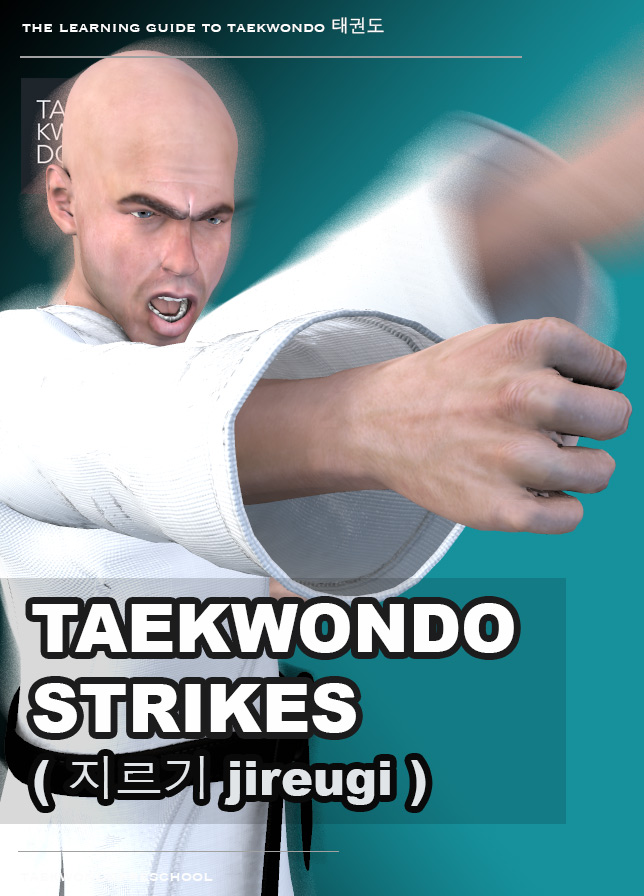
This book is available for download with Apple Books on your Mac or iOS device, and with iTunes on your computer. Book can be read with Apple Books on your Mac or iOS device.
Various surfaces of the hand ( 손 son ) may be engaged as the striking surface depending on which area of the opponents body is being targeted. Striking ( 치기 chigi ) are taekwondo techniques striking with the twisting force of the body excluding techniques using the fist ( 주먹 jumeok ) or fingertips ( 손끝 sonkkeut ). Thrusting ( 찌르기 Jjireugi ) are techniques striking with the fingertips ( 손끝 sonkkeut ). Chopping ( 찍기 Jjikgi ) are techniques striking with curled fingers. This leads to a large array of hand positions and taekwondo also makes use of reverse and front elbow strikes ( 팔굽 치기 palgup-chigi ).
View more information about Book »
TAEKWONDO STRIKES |
|||||
| Hangul 한글 | Korean | Belt Requirement | Difficulty Level | Tutorial | |
| Fist Punch | 주먹 지르기 | jumeok-jireugi |   |
Beginner Level | Tutorial » |
| Middle Punch | 몸통 지르기 | momtong-jireugi |   |
Beginner Level | Tutorial » |
| Front Hand Middle Punch | 몸통 반대 지르기 | momtong-bandae-jireugi |   |
Beginner Level | Tutorial » |
| Low Punch | 아래 지르기 | arae-jireugi |   |
Beginner Level | Tutorial » |
| High Punch | 올려 지르기 | olgul-jireugi |   |
Beginner Level | Tutorial » |
| Rear Hand Middle Punch | 몸통 바로 지르기 | momtong-baro-jireugi |   |
Beginner Level | Tutorial » |
| Double Punch | 몸통 두번 지르기 | dubeon-jireugi |   |
Beginner Level | Tutorial » |
| Knife Hand Inward Strike | 손날 안치기 | sonnal-an-chigi |   |
Intermediate Level | Tutorial » |
| Lift Punch | 치지르기 | chi-jireugi |   |
Intermediate Level | Tutorial » |
| Back Knuckle Forward Strike | 등주먹 앞치기 | deung-jumeok-ap-chigi |   |
Intermediate Level | Tutorial » |
| Downward Punch | 내려지르기 | naeryeo-jireugi |   |
Intermediate Level | Tutorial » |
| Swallow Hand Blade Inward Strike | 제비품 손날 안치기 | jebipoom-sonnal-an-chigi |   |
Intermediate Level | Tutorial » |
| Spearhand Vertical Thrust | 편손끝 세워찌르기 | pyeonsonkkeut-sewo-jjireugi |    |
Intermediate Level | Tutorial » |
| Supporting Vertical Thrust | 거들어 세워찌르기 | kodureo-sewo-jjireugi |    |
Intermediate Level | Tutorial » |
| Elbow Turning Strike | 팔굽 돌려치기 | palgup-dollyeo-chigi |   |
Intermediate Level | Tutorial » |
| Elbow Target Strike | 팔굽 표적치기 | palgup-pyojeok-chigi |   |
Intermediate Level | Tutorial » |
| Hammer Fist Strike | 메주먹 치기 | mejumeok-chigi |   |
Intermediate Level | |
| Hammer Fist Downward Strike | 메주먹 내려치기 | mejumeok-naeryeo-chigi |   |
Intermediate Level | Tutorial » |
| Hammer Fist Outward Strike | 메주먹 바깥치기 | mejumeok-bakkat-chigi |   |
Intermediate Level | Tutorial » |
| Vertical Punch | 세워지르기 | sewo-jireugi |  |
Intermediate Level | Tutorial » |
| Turning Punch | 돌려지르기 | dollyeo-jireugi |  |
Intermediate Level | Tutorial » |
| Outward Back Fist | 등주먹 바깥치기 | deung-jumeok-bakkat-chigi |   |
Intermediate Level | Tutorial » |
| Hand Blade Outward Strike | 손날 바깥치기 | sonnal-olgul-bakkat-chigi |   |
Intermediate Level | Tutorial » |
| Hand Blade Side Strike | 손날 옆치기 | sonnal-yeop-chigi |   |
Intermediate Level | Tutorial » |
| Elbow Rear Strike | 팔굽 뒤치기 | palgup-dwi-chigi |   |
Intermediate Level | Tutorial » |
| Elbow Downward Strike | 팔굽 내려치기 | palgup-naeryeo-chigi |   |
Intermediate Level | Tutorial » |
| Side Punch | 옆지르기 | yeop-jireugi |   |
Advanced Level | Tutorial » |
| Turn Over Punch | 젖혀지르기 | jeocheo-jireugi |   |
Advanced Level | Tutorial » |
| Fist Turn-over Punch | 주먹 젖혀지르기 | jumeok jeocheo-jireugi |   |
Advanced Level | |
| Double-Fist Turn-over Punch | 두주먹 젖혀지르기 | dujumeok jeocheo-jireugi |   |
Advanced Level | |
| Downward Chop | 내려찍기 | naeryeo-chigi |   |
Advanced Level | |
| Inward Chop | 안찍기 | an-chigi |   |
Advanced Level | |
| Forward Chop | 앞찍기 | ap-chigi |   |
Advanced Level | |
| 'C' Shape Punch | ‘ㄷ’ 자지르기 | digeutja-jireugi |   |
Advanced Level | Tutorial » |
| Pulling and Punching | 당겨지르기 | danggyeo-jireugi |   |
Advanced Level | Tutorial » |
| Target Punch | 표적지르기 | pyojeok-jireugi |   |
Advanced Level | Tutorial » |
| Palm Heel Forward Strike | 바탕손 앞치기 | batangson-ap-chigi |   |
Advanced Level | Tutorial » |
| Swallow Palm Heel Front Strike | 제비품 바탕손 앞치기 | jebipoom-batangson-ap-chigi |   |
Advanced Level | Tutorial » |
| Extended Knuckle Fist | 밤주먹 지르기 | bamjumeok-jireugi |   |
Advanced Level | Tutorial » |
| Extended Knuckle Fist Turn-over Punch | 밤주먹 젖혀지르기 | bamjumeok-jeocheo-jireugi |   |
Advanced Level | |
| Bent Wrist Upward Strike | 굽힌손목 올려치기 | gupinsonmok-ollyeo-chigi |  |
Advanced Level | Tutorial » |
| Pincer Hand Strike | 집게주먹 지르기 | jipge-jumeok-jireugi |  |
Advanced Level | Tutorial » |
| Scissors Fingertip Thrust | 가위손끝 찌르기 | kawisonkkeut-jjireugi |  |
Advanced Level | Tutorial » |
| Flat Fingertips Horizontal Strike | 편손끝 엎어찌르기 | pyeonsonkkeut-eopeo-jjireugi |  |
Advanced Level | Tutorial » |
| Single Fingertip Vertical Thrust | 한손끝 세워찌르기 | hansonkkeut-sewo-jjireugi |  |
Advanced Level | Tutorial » |
| Combined Two Fingertips Vertical Thrust | 모은두손끝 세워찌르기 | moeundusonkkeut-sewo-jjireugi |  |
Advanced Level | Tutorial » |
| Combined Three Fingertips Vertical Thrust | 모은세손끝 세워찌르기 | moeunsesonkkeut-sewo-jjireugi |  |
Advanced Level | Tutorial » |
| Ridgehand Inward Strike | 손날등 안치기 | sonnal-deung-an-chigi |  |
Advanced Level | Tutorial » |
| Ridgehand Downward Strike | 손날등 내려치기 | sonnal-deung-naeryeo-chigi |  |
Advanced Level | Tutorial » |
| Fork Punch | 쳇다리지르기 | chetdar-jireugi |  |
Advanced Level | Tutorial » |
| Keumgang Punch | 금강지르기 | keumgang-jireugi |  |
Advanced Level | Tutorial » |
| Keumgang Forward Punch | 금강 앞지르기 | keumgang-ap-jireugi |  |
Advanced Level | |
| Keumgang Side Punch | 금강 옆지르기 | keumgang-yeop-jireugi |  |
Advanced Level | |


Related Articles
Taekwondo hand strikes are performed as a close distance alternative to kicks ( 차기 chagi ). Various surfaces of the hand may be engaged as the striking surface depending on which area of the opponents body is being targeted. This leads to a large array of hand positions. They are executed in a number of ways - from standing, jumping, spinning and rushing forwards. Hand strikes make up fast combinations of strikes which can leave an opponent stunned and unable to defend himself. Taekwondo also makes use of reverse, front and downward elbow strikes. For more information View Taekwondo Strikes »
- Outward Strike ( 바깥치기 bakkat-chigi )
- Turning Strike ( 돌려치기 dollyeo-chigi )
- Inward Strike ( 안치기 an-chigi )
- Twisting Strike ( 비틀어치기 bitureo-chigi )
- Downward Strike ( 내려치기 naeryeo-chigi )
- Forward Strike ( 앞치기 ap-chigi )
- Side Strike ( 옆치기 yeop-chigi )
- Upward Strike ( 올려치기 olgul-chigi )
- Target Strike ( 표적치기 pyojeok-chigi )
- Supporting Strike ( 거들어치기 kodureo-chigi )
- Pulling Strike ( 당겨치기 danggyeo-chigi )
- Closed Hand Fist Strikes ( 지르기 jireugi )
- Strike techniques ( 치기 chigi )
- Thrusting Strikes ( 찌르기 jjireugi )
- Horizontal Thrust ( 엎어찌르기 eopeo-jjireugi )
- Vertical Thrust ( 세워찌르기 sewo-jjireugi )
- Chopping Strikes ( 찍기 jjikgi )
- Low Punch ( 아래 지르기 arae-jireugi )
- Middle Punch ( 몸통 지르기 momtong-jireugi )
- High Punch ( 올려 지르기 olgul-jireugi )
- Double Punch ( 몸통 두번 지르기 dubeon-jireugi )
- Fist Strike ( 주먹 지르기 jumeok-jireugi )
- Jab Strike
- Front Hand Middle Punch ( 몸통 반대 지르기 momtong-bandae-jireugi )
- Rear Hand Middle Punch ( 몸통 바로 지르기 momtong-baro-jireugi )
- Vertical Punch ( 세워지르기 sewo-jireugi )
- Turning Punch ( 돌려지르기 dollyeo-jireugi )
- 'C' Shape Punch ( ‘ㄷ’자지르기 digeutja-jireugi )
- Target Punch ( 표적지르기 pyojeok-jireugi )
- Fork Punch ( 쳇다리지르기 chetdar-jireugi )
- Keumgang Punch ( 금강지르기 keumgang-jireugi )
- Keumgang Forward Punch ( 금강 앞지르기 keumgang-ap-jireugi )
- Keumgang Side Punch ( 금강 옆지르기 keumgang-yeop-jireugi )
- Pulling and Punching ( 당겨지르기 danggyeo-jireugi )
- Side Punch ( 옆지르기 yeop-jireugi )
- Turn Over Punch ( 젖혀지르기 jeocheo-jireugi )
- Extended Knuckle Fist Turn-over Punch ( 밤주먹 젖혀지르기 bamjumeok-jeocheo-jireugi )
- (Fist) Turn-over Punch ( (주먹) 젖혀지르기 (jumeok) jeocheo-jireugi )
- (Double-Fist) Turn-over Punch ( (주먹) 젖혀지르기 (dujumeok) jeocheo-jireugi )
- Lift Punch ( 치지르기 chi-jireugi )
- Extended Knuckle Fist ( 밤주먹 지르기 bamjumeok-jireugi )
- Downward Punch ( 내려지르기 naeryeo-jireugi )
- Knife Hand Inward Strike ( 손날 안치기 sonnal-an-chigi )
- Downward Chop ( 내려찍기 naeryeo-chigi )
- Inward Chop ( 안찍기 an-chigi )
- Forward Chop ( 앞찍기 ap-chigi )
- Hammer Fist Downward Strike ( 메주먹 내려치기 mejumeok-naeryeo-chigi )
- Hammer Fist Outward Strike ( 메주먹 바깥치기 mejumeok-bakkat-chigi )
- Outward Back Fist ( 등주먹 바깥치기 deung-jumeok-bakkat-chigi )
- Back Knuckle Forward Strike ( 등주먹 앞치기 deung-jumeok-ap-chigi )
- Elbow Turning Strike ( 팔굽 돌려치기 palgup-dollyeo-chigi )
- Elbow Target Strike ( 팔굽 표적치기 palgup-pyojeok-chigi )
- Flat Fingertips Horizontal Strike ( (편손끝) 엎어찌르기 (pyeonsonkkeut) eopeo-jjireugi )
- Single Fingertip Vertical Thrust ( 한손끝 세워찌르기 hansonkkeut-sewo-jjireugi )
- Combined Two Fingertips Vertical Thrust ( 모은두손끝 세워찌르기 moeundusonkkeut-sewo-jjireugi )
- Combined Three Fingertips Vertical Thrust ( 모은세손끝 세워찌르기 moeunsesonkkeut-sewo-jjireugi )
- Palm Heel Forward Strike ( 바탕손 앞치기 batangson-ap-chigi )
- Bent Wrist Upward Strike ( 굽힌손목 올려치기 gupinsonmok-ollyeo-chigi )
- Pincer Hand Strike ( 집게주먹 지르기 jipge-jumeok-jireugi )
- Scissors Fingertip Thrust ( 가위손끝 찌르기 kawisonkkeut-jjireugi )
- Ridgehand Inward Strike ( 손날등 안치기 sonnal-deung-an-chigi )
- Swallow Strike ( 제비품치기 jebipoom-chigi )
- Swallow Hand Blade Inward Strike ( 제비품 (손날) 안치기 jebipoom-sonnal-an-chigi )
- Swallow Palm Heel Front Strike ( 제비품 (바탕손) 앞치기 jebipoom-batangson-ap-chigi )
- Spearhand Vertical Thrust ( (편손끝) 세워찌르기 (pyeonsonkkeut) sewo-jjireugi )
- Supporting Vertical Thrust ( 거들어 세워찌르기 kodureo-sewo-jjireugi )
- Hand Blade Outward Strike ( 손날 바깥치기 sonnal-olgul-bakkat-chigi )
- Hand Blade Side Strike ( 손날 옆치기 sonnal-yeop-chigi )
- Ridgehand Downward Strike ( 손날등 내려치기 sonnal-deung-naeryeo-chigi )
- Elbow Rear Strike ( 팔굽 뒤치기 palgup-dwi-chigi )
- Elbow Downward Strike ( 팔굽 내려치기 palgup-naeryeo-chigi )


Related Articles
Taekwondo hand strikes are performed as a close distance alternative to kicks ( 차기 chagi ). Various surfaces of the hand may be engaged as the striking surface depending on which area of the opponents body is being targeted. This leads to a large array of hand positions. They are executed in a number of ways - from standing, jumping, spinning and rushing forwards. Hand strikes make up fast combinations of strikes which can leave an opponent stunned and unable to defend himself. Taekwondo also makes use of reverse, front and downward elbow strikes. View Taekwondo Strikes »
- Fist Strikes ( 지르기 jireugi )
- Strikes ( 치기 chigi )
- Thrusting Strikes ( 찌르기 jjireugi )
- Chopping Strikes ( 찍기 jjikgi )
- Striking Area
- Striking Principles
- Striking Strategies
There are five tenets defined in the International Taekwondo Federation (ITF) and several more in World Taekwondo (WT).
Indomitable Spirit ( 백절불굴 baekjul-boolgool ): "To have indomitable spirit means to have the courage to stand up for what you believe in, no matter what odds you are up against, and to always give 100% effort in whatever you do." View Taekwondo Tenets »
RESOURCES
This article uses material from the Wikipedia articles "List of Taekwondo Techniques", "Fist (hand)" and "Strikes (attack)", which is released under the Creative Commons Attribution-Share-Alike License 3.0.



